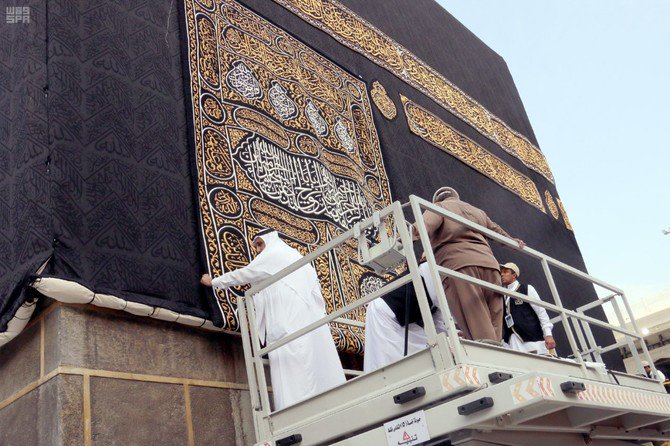
Kaaba’s replacement cloth fitted in record time
The Holy Kaaba donned a new Kiswa — a famous black cloth that covers the holiest shrine toward which Muslims face in prayer — on Monday morning after the dawn prayer.
The ceremony that involved at least 160 technicians and manufacturers was held under the supervision of Sheikh Abdulrahman Al-Sudais, the chief of the General Presidency of the Two Holy Mosques.
The Kiswa is changed every year on the ninth day of Dul Hijjah following a tradition of the General Presidency of the Two Holy Mosques.
“After the dawn prayer on the ninth day of the month of Dul Hijjah, the old Kiswa of the Kaaba is replaced by the new one, embellished by gold-plated thread illustrating verses from the Holy Qur’an,” said Ahmad bin Mohammed Al-Mansouri, director-general of the King Abdul Aziz Complex for the Kaaba.
Al-Mansouri said the new Kiswa is 658-square-meter long and is made of 670 kilograms of pure silk. For embroidery, 120 kilograms of gold thread and 100 kilograms of silver thread were used.
The Kaaba cover was manufactured at King Abdul Aziz Complex for Holy Kaaba Kiswa, which has more than 200 Saudi employees qualified and trained in the industry, added Al-Mansouri. The complex also contains the largest sewing machine in the world with a length of 16 meters.
Sheikh Abdulrahman Al-Sudais delivered a speech praising the leadership of the country for putting the service of the Holy Kaaba, the holy sites and the pilgrims at the top of its priorities.
Background
Each year Muslims from all over the world wait for the ninth day of Dul Hijjah to witness the process of replacing the cover of the Kaaba with a new one. The members of the General Presidency of the Two Holy Mosques and the Kiswa Factory of the Holy Kaaba take down the old Kiswa and replace it with a new one made of pure silk.
Dimensions
The Kiswa’s fabric is produced in the form of large pieces, each 10 centimeters wide and and 14 meters long. Each side of the Kaaba is constructed individually according to the width of each side.
The pieces are connected while maintaining the design, and then lined with cotton cloth (the same width and length), and sewn.
Due to the weight of the curtain of the Kaaba’s door, the curtain is directly attached to the wall of the Kaaba. Before changing the Kiswa, a committee of specialists in the factory review and install the embroidered pieces.
Kiswa Factory
The Kiswa Factory producing the covering for the Kaaba is keen on hiring skilled workers in all sections. This factory was built when King Abdul Aziz Al-Saud issued order to establish a separate house for the manufacturing of the Kaaba cloth in 1927.
The factory was renovated and modernized in 1976 in Umm Al-Joud in Makkah and equipped with latest machines for preparing the fabric. Even though the factory has high-tech machines for the fabric, they retained the method of manual production because of its high artistic value.
DECODER
KISWA
The new Kiswa is 658-square-meters long and is made of 670 kilograms of pure silk. For embroidery, 120 kilograms of gold thread and 100 kilograms of silver thread were used.
The factory continues to keep pace with the development, and preserve the ancient handmade heritage to produce the best Kiswa each year.
The cost of the Kiswa is approximately SR22 million ($5.8 million).
Natural silk
The fabric is made of pure natural silk, which is dyed in black. Its height is 14 meters. The upper third of the belt is 95 centimeters wide and 47 meters long, and consists of 16 pieces surrounded as a square shape of Islamic patterns or motifs.
The belt contains Qur’anic verses, each in a separate frame, and in the spaces between, in the shape of crescent, praise to and the names of Allah can be found. The belt is embossed with embroidery covered with a gold plated silver cord, which surrounds the whole Kaaba.
The cover includes a curtain of Kaaba’s door. Called a burqa, or veil, the curtain is made of silk, and is six-and-a-half-meters high and three-and-a-half-meters wide, with Qur’anic verses decorated with Islamic motifs that are embossed and covered with gold-plated silver thread. This special thread comes from Germany.
The Kiswa consists of five pieces of cloth, each covering the Kaaba on four sides and the fifth is the burqa. All these pieces are connected to each other.
Stages
The Kiswa Factory goes through several stages: The first is dyeing, in which imported raw silk is dyed in black, red or green.
The second stage is the fabric, in which the dyed fabric is converted into either silk cloth to be printed and then embroidered on the belt or curtain, or converted to the jacquard fabric.
The third phase is printing, where all the lines and patterns in the belt or curtain are printed on the cloth in the manner of wire screen in preparation for embroidery. And finally the collecting stage, in which the jacquard fabric is attached to each other to form the four sides of the Kiswa and then attaching it to the belt and the curtain, in preparation for its installation above the Kaaba.
These stages are carried out in all sections of the factory, which include manual weaving, automatic weaving, printing, flags, curtain and dyeing and construction of the belt. More than 200 qualified employees work in the factory who are considered the greatest calligraphers and artists in the Muslim world.
The factory creates the external and internal Kiswa, as well as flags and pieces that the country gives to important figures.


























